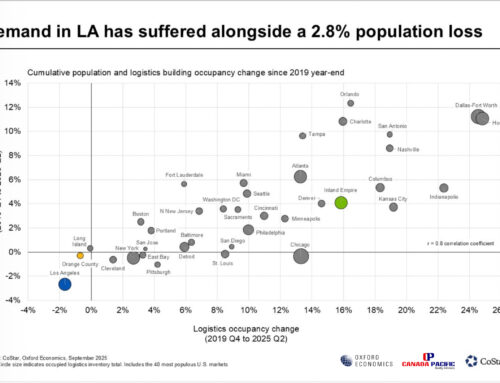The Federal Reserve Open Market Committee announced some significant changes in monetary policy: a faster tapering of bond purchases and the possibility of as many as three rate hikes in 2022. The reasons are concern about inflation, which has been more dogged than the institution had expected, and an improved job landscape. The question for commercial real estate is how the combinations of actions will affect markets.
The Fed stopped referring to inflation as “transitory,” acknowledging the condition could last longer than expected.
Moreover, rates could rise up to three times next year, with the end of 2024 seeing the Fed’s key rate at 2.1%, according to the New York Times. According to Oxford Economics, this could mean three 25-basis point hikes in 2022, three in 2023, and two in 2024.
“The hawkish forward guidance was accompanied by new economic projections pointing to a faster labor market recovery, with the unemployment rate expected to fall to 3.5% in Q4 2022, and higher and more persistent inflation – with core PCE inflation cooling to [approximately] 2.7% in Q4 2022 and 2.3% in 2023,” Oxford Economics observed in a statement.
Both the interest rate and tapering news could have a significant impact on CRE. An increased rate at which banks can borrow means higher interest rates all around, although many in real estate have been expecting this to happen in the near future for some time. Tapering reduces the amount of capital being injected into the economy, lowering the pressure on finding places to invest and, with lower demand, lower prices and values in theory. However, it’s important to remember that there are enormous sums of capital already in markets.
Also, inflation is typically good for property values. “There’s a lot of equity flocking to real estate because it’s an inflation hedge,” Tim Wallen, CEO of private equity real estate investment firm MLG Capital, tells GlobeSt.com. “Real estate generally outperforms stocks and golds through inflationary periods.”
“If interest rates are going up, that can tamp down inflation and it could reduce demand, which would bring down the price of materials and labor that go into a project,” says Mark Fawer, a partner at Greenspoon Marder. That could provide some welcome relief on the construction front, given the resurgence of lumber prices.
Source: https://www.federalreserve.gov/newsevents/pressreleases/monetary20211103a.htm, https://www.globest.com/2021/12/16/fed-clears-a-path-for-higher-interest-rates-next-year/






